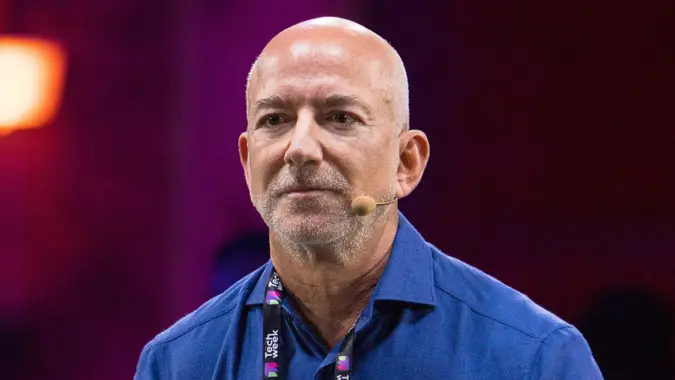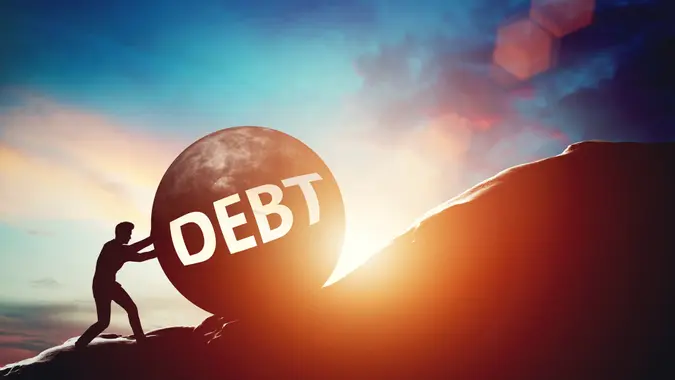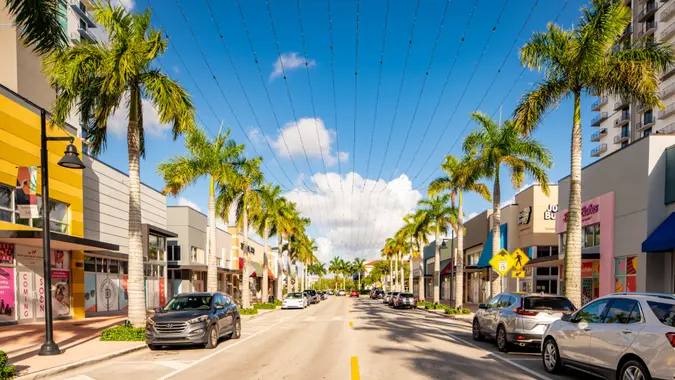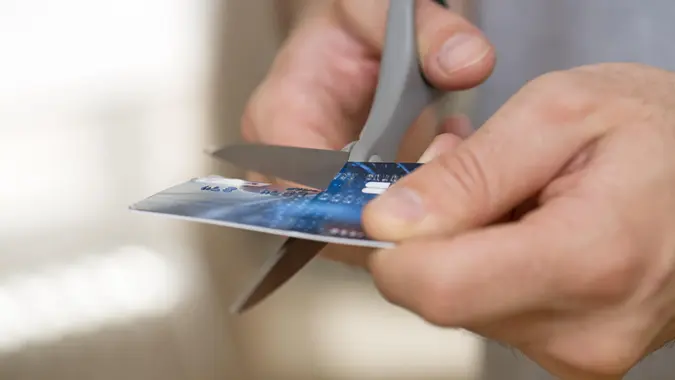10 Ways to Rebuild Your Credit After Bankruptcy

Commitment to Our Readers
GOBankingRates' editorial team is committed to bringing you unbiased reviews and information. We use data-driven methodologies to evaluate financial products and services - our reviews and ratings are not influenced by advertisers. You can read more about our editorial guidelines and our products and services review methodology.

20 Years
Helping You Live Richer

Reviewed
by Experts

Trusted by
Millions of Readers
A bankruptcy can take as much as 240 points off your credit score, depending on your situation. That hit will impact your credit score for awhile, since bankruptcies can stay on your credit report for seven to ten years after filing.
The good news, however, is that you can start to rebuild your credit score immediately following a bankruptcy.
1. Keep Debt Utilization Low
Credit utilization — the percentage of available credit you’re using–accounts for approximately 30% of your FICO score.
After bankruptcy, aim to keep this ratio under 10% for fastest credit rebuilding. If this isn’t possible, stick to 30% or less.
You can use multiple strategies for this, including:
- Try to make small purchases that you can pay off completely each month.
- Ideally, don’t make purchases on credit that you can’t pay off within the week.
- Use cash when possible to minimize purchases going on cards.
2. Make On-Time Payments
Your payment history influences 35% of your credit score — making it the single most important factor in credit rebuilding. After bankruptcy, every payment needs to be on time, every time.
Even one late payment can significantly set back your credit recovery progress, potentially dropping your score by 50 to100 points.
Tips to Always Make On-Time Payments
- Set up automatic payments or calendar reminders to ensure you never miss a due date
- Make sure you have enough money in the account for the payment to go through.
- Some credit counselors recommend paying bills a few days before they’re due to avoid any processing delays.
3. Stick to Your Repayment Plan
If you filed Chapter 13 bankruptcy, you’ll have a court-approved repayment plan that typically lasts 3-5 years. Following this plan precisely is crucial not only for your bankruptcy discharge but also for your credit rehabilitation.
Note that creditors can resume collections if you don’t maintain your repayment schedule — and they likely will. Missing payments could result in your case being dismissed, leaving you in a worse position than when you started.
4. Pay Off Any Balances
Your bankruptcy may not have discharged all debts. Any debt leftover should be prioritized and paid off as quickly as possible. This may include tax obligations, student loans and new debt acquired after filing.
Leveraging a debt snowball strategy or debt avalanche strategy can help you systematically eliminate remaining balances. The snowball method targets your smallest debts first for psychological wins and to increase monthly cash flow, while the avalanche method focuses on highest-interest debts first for maximum financial efficiency.
Either approach works, but the key is consistent progress toward becoming debt-free beyond your bankruptcy discharge.
5. Consider Secured Loans
Secured loans, backed by collateral like a savings account or CD, present lower risks to lenders and can be excellent credit-building tools after bankruptcy.
Credit unions and some private lenders may offer credit-builder loans, where you make payments first, then receive the loan amount afterward. While this may seem counterintuitive and can cost some interest, these products are specifically designed to help establish a positive payment history.
6. Become an Authorized User
Being added as an authorized user on a family member’s credit card can give your score a significant boost, provided they maintain low balances and perfect payment history.
Their account history can be reflected on your credit report, even though you’re not legally responsible for the debt. Choose someone with excellent credit habits who has held the account for several years.
7. Don’t Apply For Too Many Accounts at Once
Multiple credit applications can trigger hard inquiries, and having multiple on your score at once can temporarily lower your score and signal financial desperation to lenders.
Space out credit applications by at least six months, focusing on products specifically designed for credit rebuilding. Research pre-qualification options that use soft inquiries to check your approval odds before formally applying.
Remember that rebuilding credit is a marathon, not a sprint. Patience and strategic application timing will yield better results than desperately applying for every credit offer you receive.
8. Create a New Budget
A detailed post-bankruptcy budget is your roadmap to financial recovery. Track all income earned and every dollar spent to ensure you’re living within your means and avoiding the debt patterns that led to bankruptcy.
Some financial experts recommend the 50/30/20 approach. This involves allocating 50% of income to needs, 30% to wants, and 20% to savings and debt repayment. However, those rebuilding after bankruptcy might benefit from a more conservative 70/10/20 ratio until financial stability returns.
9. Keep Old Accounts Open After Bankruptcy
If you have any credit accounts that survived your bankruptcy or were reaffirmed during the process, keep them open and active with small, manageable purchases.
Length of credit history accounts for approximately 15% of your FICO score. Even if you rarely use these accounts, their age helps demonstrate longer-term credit relationships to potential lenders.
10. Be Patient And Consistent
Create a credit rebuilding plan with realistic timelines and celebrate small victories along the way. Even a 20-point increase represents progress in the right direction.
The consistent application of good financial habits will eventually yield results, even if the pace seems frustratingly slow at first.
The Bottom Line
Rebuilding your credit after bankruptcy can feel like an uphill battle, but it is not an impossible one. While you can’t erase the bankruptcy itself from your credit score until it falls off on its own, you can take significant strides in rebuilding your credit score with responsible debt and credit utilization.
Looking for more information on improving your credit score? Learn about rebuilding your credit to get started.
FAQ
If you’re working to rebuild your credit after bankruptcy, you might still have a few questions. Here are some answers that may help.- What is the fastest way to rebuild your credit after bankruptcy?
- The fastest way to rebuild your credit after bankruptcy is to make responsible financial decisions, including sticking to your repayment plan, making on-time payments, and keeping debt utilization low.
- Is it possible to get an 800 credit score after bankruptcy?
- Yes, it's possible to get an 800 credit score after bankruptcy, but it’s highly likely that you’ll need to wait for the bankruptcy to come off your credit score before you can reach 800.
- How to get a 700 credit score after bankruptcy.
- To get a 700 credit score after bankruptcy, make sure you’re making all payments on-time, paying off your balances, keeping debt utilization low and demonstrating a responsible relationship with credit and loans.
- How long does it take your credit to recover after filing bankruptcy?
- You can start rebuilding your credit right away after filing for bankruptcy, but the bankruptcy itself will remain on your credit score for 10 years, and a chapter 13 bankruptcy will remain on your credit score for seven years.
Our in-house research team and on-site financial experts work together to create content that’s accurate, impartial, and up to date. We fact-check every single statistic, quote and fact using trusted primary resources to make sure the information we provide is correct. You can learn more about GOBankingRates’ processes and standards in our editorial policy.
 Written by
Written by  Edited by
Edited by 

























